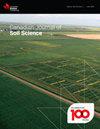Revised proposed classification for human modified soils in Canada: Anthroposolic order
IF 1.5
4区 农林科学
Q4 SOIL SCIENCE
引用次数: 2
Abstract
Abstract As the global human population and associated anthropogenic activities rapidly increase, so does the areal extent of disturbed soils. Regulatory frameworks must incorporate reclamation criteria and management options for these disturbed soils, requiring consistent descriptions and interpretations. Many human-altered soils cannot be classified using the current Canadian System of Soil Classification (CSSC), thus an Anthroposolic order is proposed. Anthroposols are soils that are highly modified or constructed by human activity, with one or more natural horizons removed and replaced, added to, or significantly modified. Disturbed horizons are anthropic in origin and contain materials significantly modified physically and/or chemically by human activities. Three great groups are defined by the presence of anthropogenic artefacts and organic carbon content. Eight subgroups are based on the amount of organic material, thickness of horizons, material composition, hydrologic regime, and presence of permafrost. Traditional phases and modifiers are used as in the CSSC. The proposed classification has been revised from the original publication in 2012 after field testing and discussion among soil scientists across Canada. This revised classification is proposed for inclusion in the revised CSSC, to account for the very large and expanding aerial extent of disturbed soils in Canada, and to remain current with other global soil taxonomy systems.加拿大人类改良土壤的修订拟议分类:人工土壤目
随着全球人口和相关人为活动的迅速增加,受干扰土壤的面积也在增加。管理框架必须纳入这些受干扰土壤的复垦标准和管理方案,需要一致的描述和解释。许多人为改变的土壤不能用现行的加拿大土壤分类系统(CSSC)进行分类,因此提出了一个人类时代的分类顺序。人溶土壤是由人类活动高度改变或构成的土壤,其中一个或多个自然层被移除、替换、添加或显著改变。扰动层是由人类活动引起的,其中含有经人类活动在物理上和/或化学上显著改变的物质。根据人为人工制品的存在和有机碳含量划分了三大类。根据有机物质的数量、地层厚度、物质组成、水文状况和永久冻土层的存在,划分出八个亚组。与CSSC一样,采用了传统的相位和修饰符。在经过加拿大各地土壤科学家的实地测试和讨论后,拟议的分类已经从2012年的原始出版物中进行了修订。这一修订后的分类被提议纳入修订后的CSSC,以说明加拿大非常大的和不断扩大的受干扰土壤的空中范围,并与其他全球土壤分类系统保持同步。
本文章由计算机程序翻译,如有差异,请以英文原文为准。
求助全文
约1分钟内获得全文
求助全文
来源期刊

Canadian Journal of Soil Science
农林科学-土壤科学
CiteScore
2.90
自引率
11.80%
发文量
73
审稿时长
6.0 months
期刊介绍:
The Canadian Journal of Soil Science is an international peer-reviewed journal published in cooperation with the Canadian Society of Soil Science. The journal publishes original research on the use, management, structure and development of soils and draws from the disciplines of soil science, agrometeorology, ecology, agricultural engineering, environmental science, hydrology, forestry, geology, geography and climatology. Research is published in a number of topic sections including: agrometeorology; ecology, biological processes and plant interactions; composition and chemical processes; physical processes and interfaces; genesis, landscape processes and relationships; contamination and environmental stewardship; and management for agricultural, forestry and urban uses.
 求助内容:
求助内容: 应助结果提醒方式:
应助结果提醒方式:


